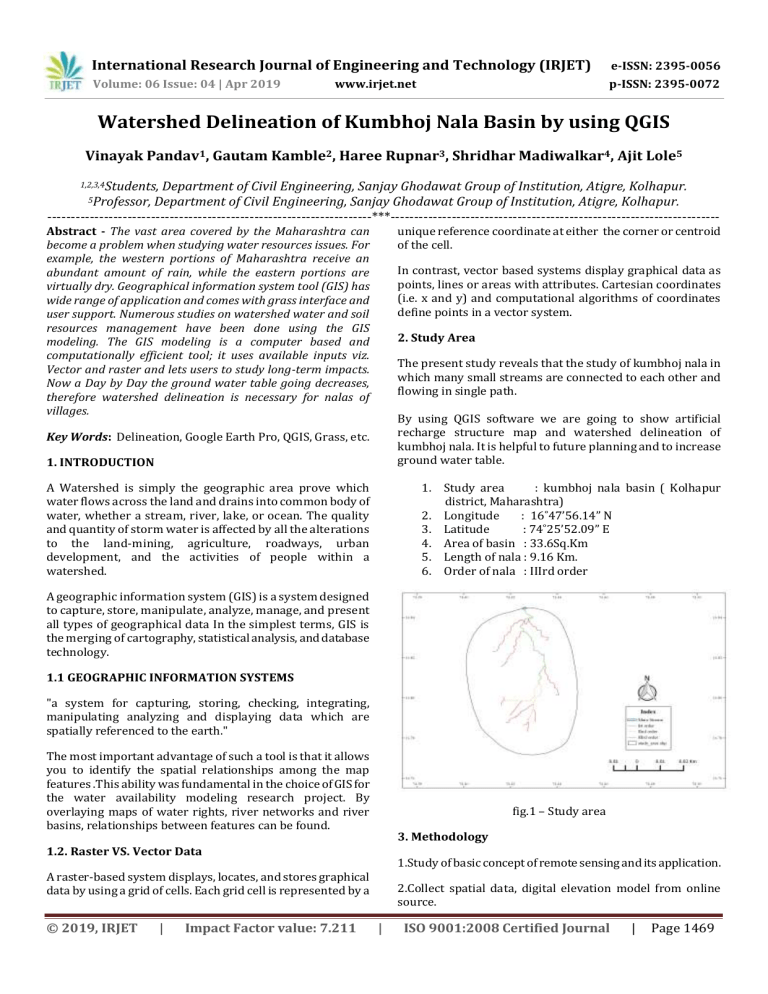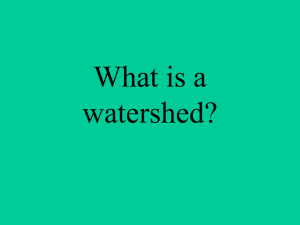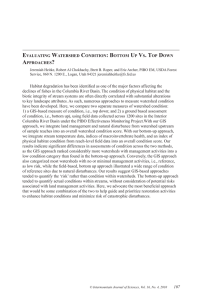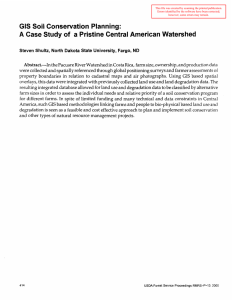IRJET- Watershed Delineation of Kumbhoj Nala Basin by using QGIS

International Research Journal of Engineering and Technology (IRJET)
e-ISSN: 2395-0056
Volume: 06 Issue: 04 | Apr 2019 www.irjet.net p-ISSN: 2395-0072
Watershed Delineation of Kumbhoj Nala Basin by using QGIS
Vinayak Pandav
1
, Gautam Kamble
2
, Haree Rupnar
3
, Shridhar Madiwalkar
4
, Ajit Lole
5
1,2,3,4
5
Students, Department of Civil Engineering, Sanjay Ghodawat Group of Institution, Atigre, Kolhapur.
Professor, Department of Civil Engineering, Sanjay Ghodawat Group of Institution, Atigre, Kolhapur.
---------------------------------------------------------------------***----------------------------------------------------------------------
Abstract - The vast area covered by the Maharashtra can become a problem when studying water resources issues. For example, the western portions of Maharashtra receive an abundant amount of rain, while the eastern portions are virtually dry. Geographical information system tool (GIS) has wide range of application and comes with grass interface and user support. Numerous studies on watershed water and soil resources management have been done using the GIS modeling. The GIS modeling is a computer based and computationally efficient tool; it uses available inputs viz.
Vector and raster and lets users to study long-term impacts.
Now a Day by Day the ground water table going decreases, therefore watershed delineation is necessary for nalas of villages.
unique reference coordinate at either the corner or centroid of the cell.
In contrast, vector based systems display graphical data as points, lines or areas with attributes. Cartesian coordinates
(i.e. x and y) and computational algorithms of coordinates define points in a vector system.
2. Study Area
Key Words : Delineation, Google Earth Pro, QGIS, Grass, etc.
1. INTRODUCTION
A Watershed is simply the geographic area prove which water flows across the land and drains into common body of water, whether a stream, river, lake, or ocean. The quality and quantity of storm water is affected by all the alterations to the land-mining, agriculture, roadways, urban development, and the activities of people within a watershed.
The present study reveals that the study of kumbhoj nala in which many small streams are connected to each other and flowing in single path.
By using QGIS software we are going to show artificial recharge structure map and watershed delineation of kumbhoj nala. It is helpful to future planning and to increase ground water table.
1.
Study area : kumbhoj nala basin ( Kolhapur district, Maharashtra)
2.
Longitude : 16˚47’56.14” N
3.
Latitude : 74˚25’52.09” E
4.
Area of basin : 33.6Sq.Km
5.
Length of nala : 9.16 Km.
6.
Order of nala : IIIrd order
A geographic information system (GIS) is a system designed to capture, store, manipulate, analyze, manage, and present all types of geographical data In the simplest terms, GIS is the merging of cartography, statistical analysis, and database technology.
1.1 GEOGRAPHIC INFORMATION SYSTEMS
"a system for capturing, storing, checking, integrating, manipulating analyzing and displaying data which are spatially referenced to the earth."
The most important advantage of such a tool is that it allows you to identify the spatial relationships among the map features .This ability was fundamental in the choice of GIS for the water availability modeling research project. By overlaying maps of water rights, river networks and river basins, relationships between features can be found.
1.2. Raster VS. Vector Data
3. Methodology fig.1 – Study area
A raster-based system displays, locates, and stores graphical data by using a grid of cells. Each grid cell is represented by a
1.Study of basic concept of remote sensing and its application.
2.Collect spatial data, digital elevation model from online source.
© 2019, IRJET | Impact Factor value: 7.211 | ISO 9001:2008 Certified Journal | Page 1469
International Research Journal of Engineering and Technology (IRJET)
e-ISSN: 2395-0056
Volume: 06 Issue: 04 | Apr 2019 www.irjet.net p-ISSN: 2395-0072
3. Interpretation of digital maps.
4. Preparation of study area maps.
5.Preparation of artificial recharge structure map.
4. Results and Discussion
a) Digital elevation model of study area- We prepared digital elevation model of study area with help of QGIS software. fig.2 – Digital elevation model map b) Slope and Aspect Map-Slope can be defined as the steepness or gradient of a unit of terrain, usually measured as an angle in degrees or as a percentage. Aspect can be defined as the direction in which a unit of terrain faces.
Fig.4 – Flow accumulation map
d) Watershed Map Of Area – watershed is an entire river or streams system or an area drained by a streams and its tributaries when rainfall on the ground it meets near by streams or river then watershed connects to big rivers that falls. Also rain water seeps through ground and joins and increase ground water table. fig.3 – Slope of area
c) Flow Accumulation Map Of Area –Flow Accumulation is a raster of accumulated flow to each cell, as determined by accumulating the weight for all cells that flow in to each down slope cells
Fig.5 Watershed map of study area
5. CONCLUSIONS
This map is prepared to assist the artificial recharge structure and their installation where the maximum achivements can get. In below map the maximum amount of streams are jioning each other and flowing in single path so we shows the artificial bund to arrest the water in greater amount. Then it is possible to rise water table in well and borewell also we can use water for farming purpose by using pumping system
© 2019, IRJET | Impact Factor value: 7.211 | ISO 9001:2008 Certified Journal | Page 1470
International Research Journal of Engineering and Technology (IRJET)
e-ISSN: 2395-0056
Volume: 06 Issue: 04 | Apr 2019 www.irjet.net p-ISSN: 2395-0072
Fig.6 Artificial recharge structure map
ACKNOWLEDGEMENT
We are thankful to village people of kumbhoj for supporting to implement the project and for providing necessary help regarding the study. We thankful to Dr. N. K. Patil, head of civil engineering department, sanjay ghodawat institute and our project guide Miss. S. R. Patil And Co- guide Mr. A. A. lole for providing necessary support for completing the study successfully.
REFERENCES
1.
Jean-pierre fortin, 1 richard turcotte, 2 serge massicotte 3 roger moussa, 4 jose'e fitzback5 and jean-pierre villeneuve6, "distributed watershed model compatible with remote sensing and gis data."
I: description of model "
2.
Edsel b. Daniel, janey v. Camp, eugene i. Leboeuf,
Jessica R. Penrod, mark d. Abkowitz, and james p.
Dobbins "watershed modeling using gis technology: a critical review", journal of spatial hydrology vol.10, no.2, fall 2010
3.
Dhirendrapandey, anil kumar shukla, abhinavshukla
"gis: scope and benefits" (2014)
4.
Abhishek p. Sinh, d. G. Regulwar, "sustainable technologies in civil engineering" research article impact factor: 4.226 issn: 2319-507x abhishek p.
Sinh, ijpret, 2015; volume 3 (8): 287-295 ijpret
(2012)
© 2019, IRJET | Impact Factor value: 7.211 | ISO 9001:2008 Certified Journal | Page 1471




